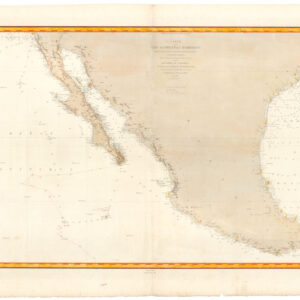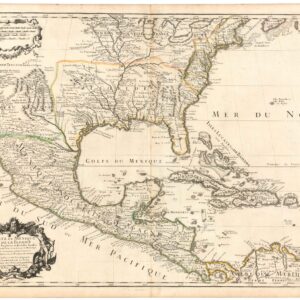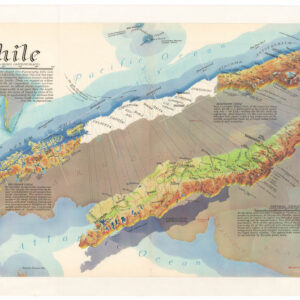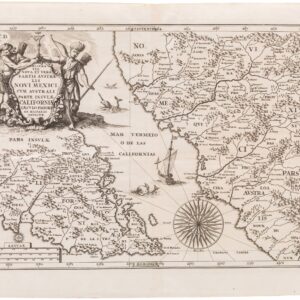De Bry’s seminal map of South America: a manifestation of the courage, determination, and megalomania of those who went forth to explore an unknown world.
Americae pars magis cognita. [First State]
Out of stock
Description
One of the earliest and most attractive folio maps of South America on the market.
Produced during the paradigm-setting late 16th century, this stunning chart was issued in the third book of Theodor de Bry’s Grand Voyages, which included the accounts of Hans Staden (1548-55) and Jean de Léry’s (1557-58) travels among the Tupinambá people of northeastern Brazil. Despite the focus on South America, the map includes a significant portion of the North American continent, including all of Central America and a large swathe of what is today the southern United States. At the time, this scope made a lot of sense, for while Brazil may have fallen under the aegis of the Portuguese, De Bry was essentially showing the full extent of Spanish Dominion in the Americas.
Our example of this landmark map is the rare First State (without the addition of the plan of Mexico City, and other features), published in the original edition of the third book in 1592. The northern part of the map essentially constituted an expansion of De Bry’s map of Florida, which he had published the previous year and was based heavily on Jacques le Moyne de Morgue’s original.
Sources
De Bry’s sources continue to elicit debate and contention among scholars when it comes to the geography and toponymy of South America. De Bry was an expert at bringing narratives to life through his detailed illustrations. But to discern and visualize an entire continent’s geography in this manner was a greater challenge. De Bry would likely have turned to the printed maps available at the time. These included maps by Italian, Spanish, and Dutch cartographers like Ruscelli (1561), Gutierrez (1562), Forlani (1562), Gastaldi (1565), Ortelius (1570), and Peter Martyr d’Anghiera (1587).
When looking at continental geography from a modern perspective, one of the more obvious errors is the southwest coast, in what today is Chile. The prominent bulge or promontory extending into the Pacific is a feature that belongs to the earliest days of South American cartography.
While many consider the mapmakers of 16th century Italy a primary source for De Bry, even a superficial survey of their output will tell you that Italian cartographers were largely unconvinced of this configuration. On the other hand, the early Dutch schools appear to have accepted the bulge. The most prominent example of this is the First State of Ortelius’ map of the Americas (1570), which includes an even more significant bulge than that suggested by De Bry. Ortelius already removed this feature in the Second State of his map (1587), and thus De Bry may be considered the last mapmaker to include this particular concept on a printed map.
An extensive Amazon riverine system
The engraving of the map is exceptionally well executed, testifying to the De Bry Family’s multi-generational experience with the art. Among the cartographic features worth noting is the rather extensively rendered Amazon River emptying into a large northern delta. While De Bry draws on the schematic representations common in early maps of the Amazonian interior (e.g. Gutierrez 1562), it is also notable how he made an effort to render the complex riverine systems of South America in a more organic and naturalistic fashion. Another highlight of the map is the finely rendered Magellan Straits at the bottom. Here, one might note how De Bry did not find it pivotal to depict the complete outline of the continent, as much as it was essential to provide a faithful and detailed representation of the Portuguese navigator’s game-changing discovery from 1520.
Compositional quality
In addition to the vivaciousness of the cartography itself, two gorgeous strap-work cartouches are located in both the bottom corners of the map. While the one on the left describes the map’s contents and notes on the maker in Latin, the right cartouche contains information on the measurements applied in its compilation. It is augmented by the inclusion of a mapmaker’s compass balancing atop the strap-work. In the upper corners of the map are the coats-of-arms of the royal houses of France and Spain, and between them, a putto carries a banner with the map’s title. Other remarkable details include two gorgeous 16-point compass roses in the Pacific and Atlantic Oceans, respectively, a monstrous whale off northeast Brazil and a large Caravel sailing on the Magellan Straits.
De Bry’s collection of Grand Voyages was an illustrated collection of accounts of the Americas, published in thirteen volumes between 1590 and 1634. The accounts and images compiled by De Bry were hugely popular, and new editions were issued well into the 17th century. While no other European writer had compiled such a comprehensive compendium of accounts, the incredibly vivid illustrations in De Bry Voyages fascinated and horrified the European gentry in equal measure.
In many ways, it was De Bry who shaped the first European ideas of the New World.
Cartographer(s):
Theodor de Bry (1528 – 1598) was a Flemish engraver, goldsmith, and publisher from Liège in the Spanish Low Countries (today Belgium). Being a Calvinist protestant, De Bry was sentenced to perpetual banishment in 1570 and forced to flee the Spanish-controlled Netherlands to avoid further persecution by the Inquisition. He moved from place to place, staying within the confines of Protestant Europe and working from cities like Strasbourg (1570-77), Antwerp (1577-1585), and London (1585-88) until he finally settled down more permanently in Frankfurt in 1588. In London, De Bry met Richard Hakluyt and developed a similar interest in the great voyages of discovery that characterized the age.
Having come from a line of highly skilled engravers and jewelers, Theodore De Bry was a bit of a polymath, dabbling proficiently in several different fields but none as successfully as in printing and publishing. He edited and published numerous works, many of which would become hugely popular, and was especially renowned for the vivacious grace of his illustrations, which in many cases depicted things and ideas to which European audiences had never before been exposed.
Most of De Bry’s books were about the early European expeditions to America (both North and South). Acting primarily as a compiler of information, De Bry relied heavily on first-hand observations by explorers, seamen, and conquistadors. While tall tales attracted their fair share of attention, it was especially De Bry’s detailed illustrations of the first expeditions to America (both north and South) that captivated peoples’ imaginations and propelled his work into the highest literary circles of late 16th-century society.
De Bry set up his business in Frankfurt with his sons, who inherited it after their father’s death. In 1626, De Bry’s grandson-in-law, the Swiss engraver Mathäus Merian, took over the firm. Because the De Bry firm was multi-generational and the engraved illustrations they published were rarely signed, many of the plates have been attributed to Theodor posthumously.
The most famous publication issued by De Bry was a series of volumes entitled Collectiones peregrinatiorum in Indiam orientalem et Indiam occidentalem, XIII partibus comprehenso a Theodoro, Joan-Theodoro de Bry, et a Matheo Merian publicatae. Francofurti. 1590–1634. Of the 13 books, I to VI were edited and illustrated by Theodor de Bry himself, while books VII to XII were edited and engraved by his sons, Johann Theodor and Johann Israel De Bry, and book XIII was engraved and published by Mathäus Merian. Book IV is perhaps the most famous of the thirteen volumes, as this deals with North America. The books provided the first detailed illustrations of the New World. To make these as realistic as possible, De Bry would use original paintings and watercolors by pioneers like Roanoke’s colonial governor and mapmaker John White or the French explorer and artist Jacques le Moyne de Morgue.
Condition Description
Perhaps expertly silked, all but indiscernible, fine.
References



